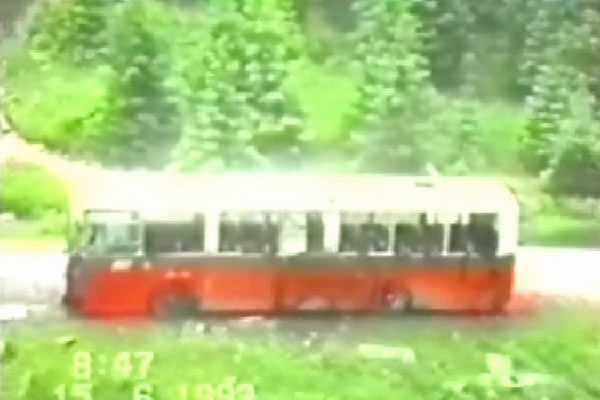Home
SURVIVOR OF BUS MASSACRE GIVES EVIDENCE
A survivor from the bus massacre of 14 June 1992 testified at the trial of Radovan Karadzic. About 50 Bosniaks trapped in a bus were killed with rocket launchers, infantry arms and hand grenades. The accused contends that the Muslim forces attacked the bus, because, as he put it, ‘Serbs wouldn’t destroy their own bus’
 Bus in which about 50 Bosniaks were killed
Bus in which about 50 Bosniaks were killed ‘I drank the blood of my relatives and neighbors as it poured down to the floor on which I lay. My face and mouth were on the floor, there was so much blood. Unbearable.’ This is how prosecution witness testifying under the pseudonym KDZ 041 described the scene in the bus in which about 50 persons were killed on 14 June 1992 in the village of Sokoline. The witness gave evidence via video link with identity protection and image distortion at the trial of former Republika Srpska president Radovan Karadzic.
The witness lived in Ahatovici, a village in the municipality of Novi Grad, which was part of Sarajevo. In late May 1992, Ahatovici was attacked by the Serb forces. The witness tried to flee into the woods with about 30 people, but they were stopped. Half of them were killed and the others were detained in two fuel tanks in the air base in Rajlovac. More than 200 persons were held in the fuel tanks, the witness claimed. Among them were Hajra Delic and Enver Celik. The witness said that Delic died after a beating while Celik was hanged and his ‘spine was broken with a stick’.
The prisoners remained in the fuel tanks until 14 June 1992, when ‘the Serbian special forces’ dressed ‘like guerillas’ with black masks over their faces ordered them to board a bus. ‘For their own safety’ they were ordered to lie face down on top of each other.
The prisoners were told that they were going to Kobilja glava to be exchanged, but the bus with 55 prisoners on board stopped in the village of Sokolina, near a stream. The driver and two guards got off under the pretext that the engine had to cool down. After that, the witness heard and felt a ‘strong detonation’ of a shell that hit the ‘mass of people’. Then the ‘fire from infantry arms started’ followed by two even stronger detonations and the explosions caused by hand grenades thrown under the bus. After 15 minutes, ‘everything went quiet’: the only sound was ‘the moaning’ the witness heard in the bus. The witness told the people to ‘keep quiet’ because otherwise the soldiers would return and finish off the survivors. After that ‘there was not a peep’, the witness said.
The witness remained under the dead bodies for a while. Then, together with a handful of other survivors, he managed to get into a nearby forest. The witness sought shelter in the Muslim village of Vukasovici. The next day, the commander of the Territorial Defense from Vukasovici sent some men in two tractors with trailers to get the dead from the bus and bury them.
In his cross-examination, Radovan Karadzic put it to the witness that the bus had been stopped and ‘ambushed’ at the demarcation line between the Muslim and Serb forces. Recalling an intercepted conversation between Momcilo Krajisnik and his brother Mirko, Karadzic claimed that the Muslims were responsible for the attack because they thought that Serbs were in the bus. According to Karadzic, it was not logical for ‘Serbs to destroy their own bus’.
Ramiz Mujkic took the stand after Witness KDZ-41 completed his evidence. Mujkic’s 13 relatives were killed in the massacre. Mujkic himself was arrested in August 1992 and taken to a prison camp in Rajlovac, where his jaw was broken. He met Nikola Poplasen and Mirko Krajisnik there; they wanted the witness to tell them the whereabouts of Hasan Mujkic, the commander of the Territorial Defense in Ahatovici. Because his jaw was broken, the witness couldn’t speak and they gave him a piece of paper to write down his statement. Ramiz Mujkic will continue his evidence on Tuesday.
Linked Reports
- Case : Karadzic
- 2011-02-16 CHAOS, GOSSIP AND POSITIVE DISCRIMINATION IN HADZICI
- 2011-02-15 KARADZIC – VICTIM OF DOUBLE CONSPIRACY
- 2011-02-14 CRISIS STAFFS IN ‘ROUGH AND HARD TIMES’
- 2011-02-22 PROFESSOR ZECEVIC MOVES FROM DOCK TO WITNESS STAND
- 2011-02-23 KARADZIC, ZECEVIC AND THE LAWS OF PHYSICS
- 2011-02-24 KARADZIC’S MARKALE THEORIES
